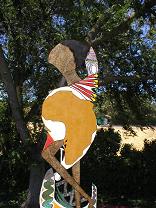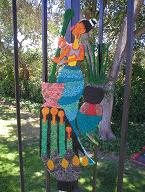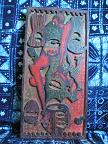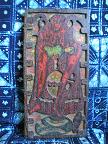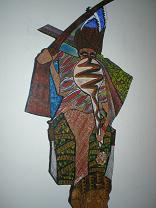Welcome to: Plywood Cut Etching
Discovered, and named Plywood Etching in 2002, by Adekunle Kabir Adejare
Plywood
Plywood is a type of engineered wood made from thin sheets of wood veneer, called plies or veneers. The layers are glued together, each with its grain at right angles to adjacent layers for greater strength.There are usually an odd number of plies, as the symmetry makes the board less prone to warping, and the grain on the outside surfaces runs in the same direction. The plies are bonded under heat and pressure with strong adhesives, usually phenol formaldehyde resin, making plywood a type of composite material. Plywood is sometimes called the original engineered wood.
A common reason for using plywood instead of plain wood is its resistance to cracking, shrinkage, twisting/warping, and its general high degree of strength. It has replaced many dimensional lumbers on construction applications for these reasons.
Types of plywood
A vast number of varieties of plywood exist for different applications. Softwood plywood is usually made either of Douglas fir or spruce, pine, and fir, and is typically used for construction and industrial purposes. Decorative plywood is usually faced with hardwood, including red oak, birch, maple, lauan (Philippine mahogany) and a large number of other hardwoods.
Plywood for indoor use generally uses the less expensive urea-formaldehyde glue which has limited water resistance, while outdoor and marine grade plywood are designed to withstand rot, and use a water resistant phenol-formaldehyde glue to prevent delamination and to retain strength in high humidity.
The most common varieties of softwood plywood come in three, five or seven plies with a metric dimension of 1.2 m by 2.4 m or the slightly larger imperial dimension of 4 feet by 8 feet. Plies vary in thickness from 1/10" through 1/6" depending on the panel thickness. Roofing can use the thinner 5/8-inch plywood. Subfloors are at least 3/4-inch depending on the distance between floor joists. Plywood for flooring applications is often tongue and grooved. The mating edge will have a "groove" notched into it to fit with the adjacent "tongue" that protrudes from the next board. This keeps the boards from slipping past each other providing a solid feeling floor when the joints do not lie over joists. Tongue & groove flooring plywood is typically 1" in thickness.
High-strength plywood, known as aircraft plywood, is made from mahogany and/or birch, and uses adhesives with increased resistance to heat and humidity. It was used for several World War II fighter aircraft, including the British-built Mosquito bomber.
moreA.K.A.'S Inspiration Art for all
This is the site where we gladly share our styles and techniques with everyone.


